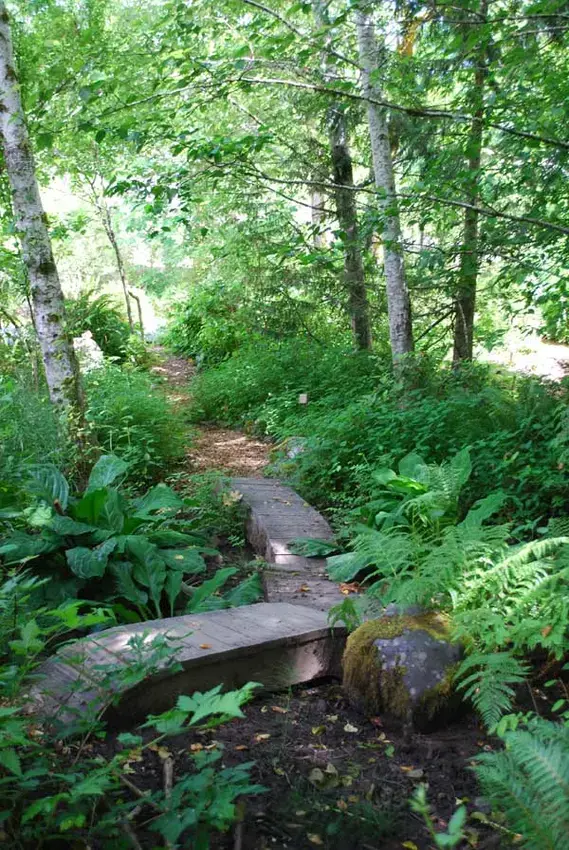
The Gifts Garden
The House of Welcome expresses itself beyond its internal walls in the lush garden that surrounds it.
The Gifts Garden—shortened from "Gifts of the First People," consists of several ethnobotanically-oriented habitat and theme areas, and honors the late Skokomish cultural leader, subiyay, G. Bruce Miller. subiyay first gave this name to a related garden project on the Skokomish Indian Reservation and served as a mentor for the garden at the Longhouse as it developed and grew. Now we give back our appreciation to subiyay by dedicating the garden to him.
The original vision for The Gifts Garden emerged before the House of Welcome was built in 1994. Colleen Jollie, the original House of Welcome project coordinator, and Marja Eloheimo, long-term contingent faculty, were both inspired by the idea of an ethnobotanical garden on the site, especially when a funding shortfall prevented installation of the landscape plans. Eloheimo struggled for, committed to and eventually received permission for her current and future students to develop and care for a garden that features plants that are native to the Pacific Northwest and that are arranged in habitat areas reflecting the conditions in which they would naturally occur. This became the first of Evergreen's teaching gardens. Today the garden contains forest, wetland, riparian, prairie and high elevation habitats, as well as "theme" areas that focus on demonstrating edible forest systems, creating habitat for pollinators, and replicating a medicinal plant garden, which were co-developed with subiyay on the Skokomish Indian Reservation.
Five Purposes of the Garden
- To honor, preserve and better understand native plants of the Pacific Northwest. In this garden, we show the plants respect in several ways. For example, approximately 80% of the plants present have been salvaged from development sites. In order to plant these and other plants in suitable locations, we deepen our understanding of their growth needs and habitat affinities. We include name signs (with the English, Twana, Lushootseed, Twelshootseed, Chehalis and Latin names) to help visitors learn to recognize and identify the plants.
- To acknowledge the close traditional relationships between Native people and native plants. A garden of exactly this type would not have been traditional in this region. Nor would many of the plants present have occurred at a traditional Longhouse site. However, the location of The Gifts Garden draws attention to how deeply and fully First Peoples have understood their plant relatives and with what great care they have interacted with them. Additionally, plant names in local Indigenous languages are included whenever possible on plant identification signs. This purpose supports the type of learning that situates understanding of traditional plant knowledge within larger cultural contexts as well as integrates ecological with cultural sustainability.
- To provide a living resource for learning. This garden provides an opportunity for engaging with living plants and with dynamic-interactive habitats. The possibilities for engagement are enormous. They include contemplation, observation, description, measurement, drawing, tending, harvesting, processing, utilization, design, interpretation and planting, among others.
- To provide opportunities for interdisciplinary, intercommunity and intercultural exchange and collaboration. This garden offers resources and inspiration for students of the humanities, the arts, culture, natural sciences, environmental sciences, chemistry, language, education, psychology and social and health sciences, to expand learning within their own discipline, to integrate learning across disciplines and to collaborate with students of other disciplines. Likewise, the garden supports members of various communities outside of Evergreen - such as public schools, tribal communities and other cultural groups, to engage in learning activities independently or collectively.
- To restore and enhance the landscape at the House of Welcome. After the land was cleared, a landscape of mostly mud remained. A few ferns were salvaged from the original site. The additional early plantings were largely salvaged from sites to be developed and used to establish the habitat areas. Some of the habitats represent those that would naturally be present at this site, while others do not. The process of enhancing this educational landscape is ongoing and open to coordinated participation.
Finally, before her passing, esteemed Lushootseed scholar, storyteller, elder and grandmother, Vi taqʷšəblu Hilbert (Upper Skagit), graced the garden with the Lushootseed name, s'uləxw. Her eloquent explanation of the name's meaning is:
"We can really make use of, by gathering, the things the Creator has given us to gather. The life of the plant is provided by the Creator. It is ours to gather and then make use of. We are given the privilege of taking these things for our own use. We help ourselves. In doing so, we are honoring the Creator. These things are so special."
We hope to express and teach this wisdom through our ongoing care for The Gifts Garden and through others' experience of it.